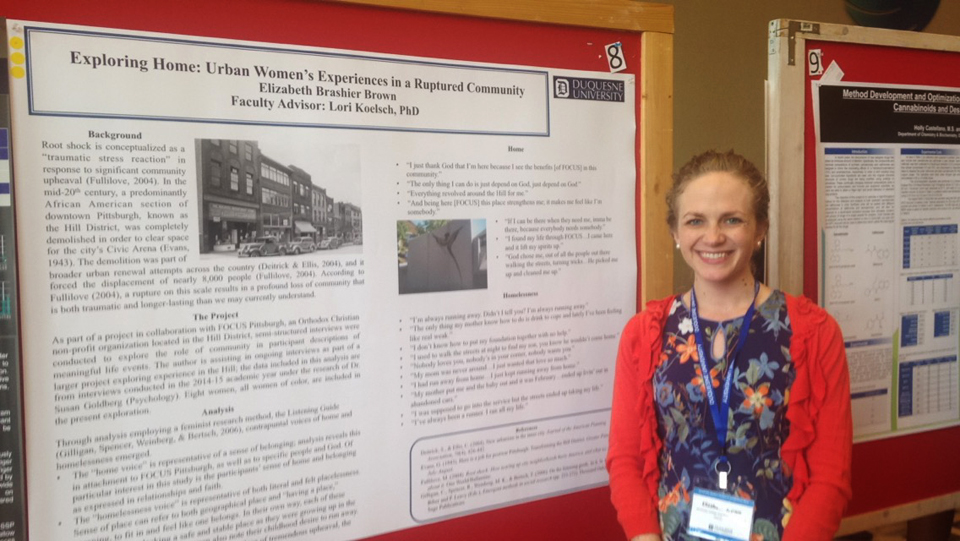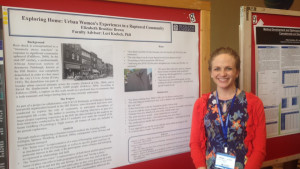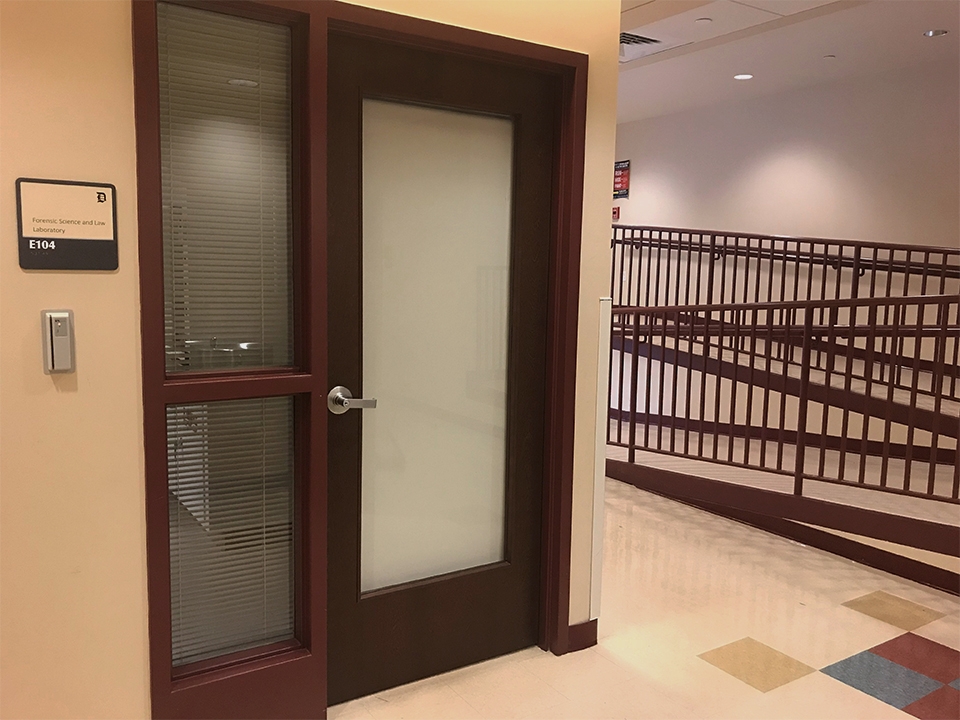

Graduate psychology student Elizabeth Brown stands next to a poster that explains her research project at the 2015-16 Graduate Research Symposium.
By Kayla Casavant | The Duquesne Duke
Music, homelessness and medical ventilators: The topics introduced at Duquesne’s third annual Graduate Research Symposium spanned a variety of topics and showcased the many different talents and specialties of almost 100 Duquesne graduate students.
Participants gathered in the Power Center Ballroom Nov. 8 to present their work to judges, fellow classmates and curious passersby.
The presenting students came from disciplines such as psychology, medical ethics, earth sciences, music and history. During the day-long event, they had the opportunity to display information on corkboards and answer questions from judges.
Elizabeth Brown, a graduate psychology student at Duquesne, studied “root shock” in the Hill District; a phenomenon that occurs when a community is displaced or demolished. Brown looked into the effects the construction of Mellon Arena had on the Hill community.
Brown used the “feminist research method,” which uses personal accounts from women to draw conclusions. Her subjects — eight black women who had lived in the Hill District their whole lives — had experienced physical or spiritual homelessness. They either were literally homeless or did not really feel that they were a part of a community.
“What we saw in these women was a voice of home and a voice of homelessness,” Brown said.
The annual symposium is sponsored by Academic Affairs, the Office of the Provost and the Office of Research and awards more than $4,000 in prize money.
The symposium is intended to give graduate students experience presenting and discussing their work with professionals within their discipline and those completely new to the topic.
Another project at the symposium focused on the specific communication needs of hospital patients on ventilators. Heather Vitko from the school of nursing studied how medical personnel interact with patients who were put on ventilators while unconscious.
“I interviewed several patients that had woken up in the hospital on a ventilator with no prior warning,” Vitko said. “When the patients recount their experience, they describe a feeling of intimidation and hopelessness.”
Vitko said she feels healthcare providers need to be held to a higher standard of care when working with these patients.
“Nurses are not very good at anticipating their needs,” she said.
Vitko hopes this research will help lead to new technology or methods to help such patients and their caregivers communicate more clearly.
“Patients [on ventilators] are more awake and aware than we think they are and have unique needs that aren’t being met at the level they need to,” Vitko said.
Benjamin Meyer, a graduate music student at Duquesne, focused his research on Igor Stravinsky’s exploration of musical space in his ballet, “Agon.” Stravinsky was a Russian composer who wrote “Agon” near the end of his career in the 1950s. The ballet is rooted in numbers. Stravinsky’s favorite number was 12 and favorite ratio was two to one, which is reflected in the piece.
Agon has 12 dancers, and the ballet has 12 parts. It features eight women and four men, hence the two to one proportion.
However, Stravinsky did not follow many of the musical rules of his contemporaries. At the heart of Stravinsky’s work, Meyer said, lays this quotation by the composer: “I plan to compose my music without any blueprint for a plot, I will compose music to dance.”
Meyer’s project discovered that while the dance is very structured, the music itself is unstructured, which Meyer claims creates “musical space.”
“Stravinsky composed music with no tonal center,” Meyer said. “In his music time is blurred, the music is in musical space.”




